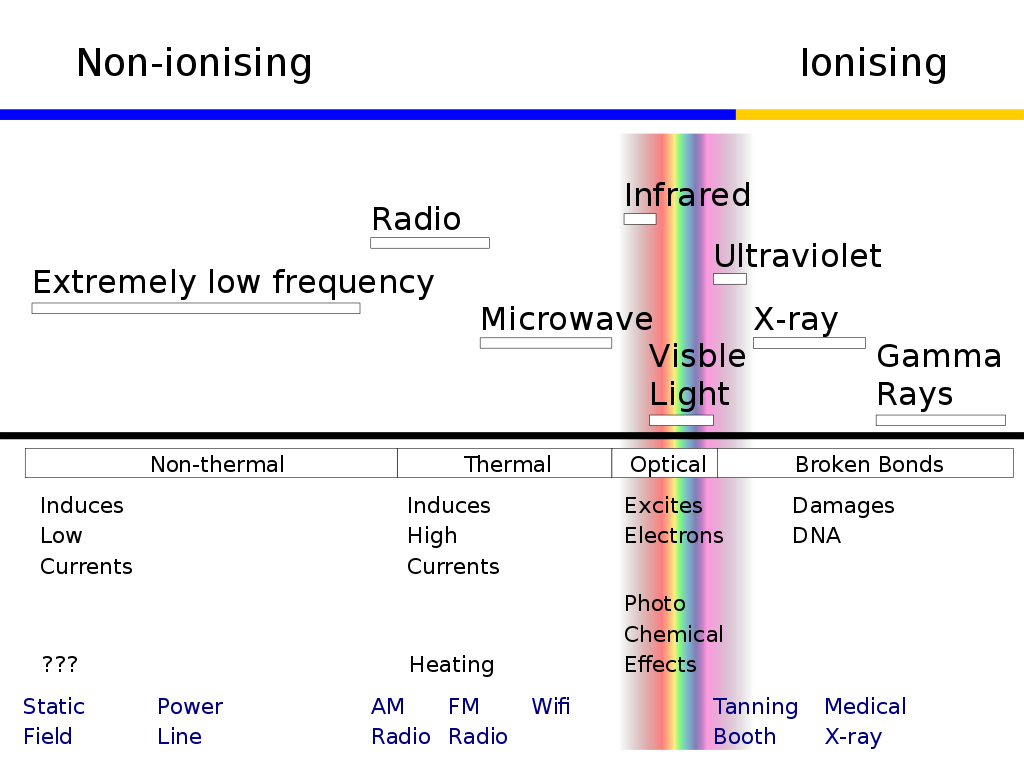Are Cell Phones and Wifi Frying Our Brains?
Everything you need to know about devices that create electromagnetic fields and radiation
Some of the best-known ways we interact with electromagnetic fields are through cell phones, wifi, microwaves, and x-rays. Basically, we interact with them or use them do to mundane, but sort of magical, tasks every day. But, have you ever wondered if and how those things affect your health? Like is standing too close to the actually microwave bad? Is carrying your cell phone in your pocket or sports bra going to ruin your sperm or give you breast cancer? Is sleeping with your phone under your pillow really a big deal? We dug through the current research to answer exactly those questions.
What are EMFs and how do they work?

First off, let’s talk about what EMF refers to. EMF is an acronym that stands for electromagnetic fields. This is kind of a fancy way of saying anything that uses electricity to do things. The way EMF works is by creating electricity, which, when it interacts with other things, changes the charges on cells to make them do different things. If that got too technical for you, basically, the thought is that electricity makes things (big and very, very small) move or react. The reason this is something we are talking about here is because as we learn new ways to harness that magical quality (think more wireless technologies like your smartwatch, Alexa, and video doorbells) we are putting more electrical charges in the environment that can interact with our bodies. A potential concern is that as those electrical impulses reach our bodies, they might be changing how our cells act and that over time that might lead to problems, like cancers or disease.
Some of the reason that EMFs can change the ways cells in our bodies work is because they encompass a whole range of different frequencies and wavelengths of energy, including radiation. We often hear about radiation and think x-rays or cancer treatment, but there is a huge spectrum of radiation. On one end, there are radio waves, in the middle is visible light (the things we can see), and the other end is x-rays and gamma rays that are sometimes used to treat cancer (10). Just because radiation is involved doesn’t always mean that it is as powerful an as x-ray. The difference that people should worry about is if the radiation is ionizing or not. Things like strong UV light (like from the sun or tanning booths) and x-rays are ionizing because they have the ability to remove electrons from atoms. Non-ionizing radiation from things like radio waves, microwaves and visible light are weaker and are generally believed to only have the potential to harm people if they generate enough heat (11).
So, how worried should we be about all these new wireless technologies?
It kind of depends.
Based on the variety of research that has been done, the results are a little all over the place. This is because it depends on the technology being studied, how often it is being used, and in what situations. Also, many of these technologies are rather new (and constantly changing), meaning there just hasn’t been enough time to study them to see how they affect people after a long period of use. However, in the limited research that has been done, scientists have concluded that the levels of radiofrequency that people interact with on a normal basis are low enough that they really don’t pose a threat to human health(1, 11). While there is consensus that there isn’t a general threat, nobody has been able to prove that constantly interacting with EMF radiation is safe either. The International Agency for Research on Cancer (IARC) has classified EMF as a possible carcinogen (along with dozens of other things we commonly come into contact with) (20). And, there are isolated studies that have linked it to potential adverse health outcomes, like miscarriages, in certain groups of people who may be more vulnerable (21).
The bottom line is that scientists are still working on the answers. And as we use more and more types of technologies that generate non-ionizing radiation (hello wifi enabled water bottles and umbrellas?!), we can expect more scientific studies to be done on what this all means for your health. This leaves a lot of people wondering and promoting precautions. We’ll go through a couple of the most common forms of EMF, lay out what the experts are saying, and give you a few suggestions for ways you can take precautions, if you’re a better safe than sorry kind of a person.

Cell Phones
This is the big one here with the most research. Cell phones still fall in the category of non-ionizing radiation, but they are at a higher level on the radiation spectrum than wifi or Bluetooth (6). There are some studies that have found that prolonged use of cell phones can impact some types of functional memory (7), but everyone agrees that more research is needed to draw conclusions (1, 6). In a report from the partial findings of a study done by the National Toxicology Program using rats as subjects (which is a common way to get information on health more quickly than with humans since rats have more generations of babies in less time), researchers found that prolonged exposure to cell phone radiation for 2G and 3G signal is likely the cause of increased rates of cancer in both the brain and heart in male rats (13). They didn’t find statistically significant differences for female rats who were exposed to the same amount of cell phone radiation and aren’t sure why. They are hoping to do more studies to learn effects of different types of cell phone radiation, including with updated technologies like 4G and 5G, but they are pretty sure that cell phone radiation is at least linked to higher cancer rates in male rats (14). Others say that very high levels of non-ionizing EMF can hurt you (like cause a burn), but not cause cancer or tumors (8). The most recent NIH studies researching the effects of cell phone use and cancer also have not been able to show strong links between cell phone use and increased cancer risk (15).
While more research is being done, there are still recommendations of easy changes that could reduce your exposure to EMF from cell phones – because being cautious is never a bad thing. The California Department of Public Health, which issued a statement on the matter, and other groups including the FDA suggest:
- keeping your phone away from your body (14, 19) (men that means out of your pockets, ladies probably not the best to shove it in your sports bra). Try keeping it in your bag when you’re on the move and on a table when you are working or hanging out at home.
- Using headphones or speakerphone when you make a call, especially if you are moving or have bad or spotty signal. Those situations cause cell phones to use more energy, which can create higher levels of EMF. Sounds like a great excuse to text more to us! (9, 14)
- Keeping your phone out of and away from your bed at night or in airplane mode for the night. Do you really need to sleep with your cell phone under your pillow? Try keeping it on your dresser if you use it as an alarm, or in the other room if you can.
- If you have kids, don’t let them use your phone as a chew toy (the slobber is probably not great for the phone either). Also, if you are using your phone to entertain your child, try downloading the show and then putting it in airplane mode while they watch the show instead of streaming it (3). This means the phone doesn’t have to work as hard and maintain a constant connection to service. Children with cellphones should follow the above recommendations about keeping it away from their body when possible, texting more, and using headphones or speakerphone for calls (19).

Wi-Fi
Mos of us can’t even imagine a normal day without wifi, but, when you think about it, for wifi to work there has to be something getting the internet connection from the wall to your computer, phone, e-reader, streaming device, and about a million other things. So how does that work? It’s not like those rays, waves, or particles of fairy dust are only reaching your devices – they are also hitting the table, the couch, and your body. While this is true, wifi is considered a form of non-ionizing, low-frequency electromagnetic radiation (as opposed to ionizing, which we know can cause harm). Remember that non-ionizing radiation, is generally recognized as “harmless to humans” (2, 3) unless it can generate enough heat to cause harm (11). While it is considered safe, in recent years there has been more research looking specifically at this kind of radiation to determine its effects because it has become such an integral part of daily life.
While this is widely accepted, you can still reduce your exposure a couple of ways.
- If you can, place your wifi router on a higher shelf or away from where people often sit and work.
- Try to keep your laptop off your lap or stomach when you work (or watch your favorite show). Put it on a table or even just next to you on the bed instead. This is a good thing to do anyways if your laptop battery is hot because heat in extreme amounts can damage semen quality.
- Turn your wifi router off at night when you go to sleep. You are sleeping anyway, you don’t need wifi. And, many people say turning off screens half an hour before you go to bed is good for you anyway. If you aren’t sure you can commit to not scrolling in bed, you can get a timer for the outlet your router is plugged into and automatically set it to turn off from midnight to 6 am (or whatever hours feel right for you).

Bluetooth
There has been less research done on Bluetooth because Bluetooth is essentially a weaker form of wifi, which is why it doesn’t reach as far. But, since many studies have determined that wifi is generally safe, most assume the same is true of Bluetooth (4). Much of this is based on the science of how both wifi and Bluetooth work (5).
Because Bluetooth is so weak, there are very few recommendations about it. In fact, many organizations suggest using headphones (including Bluetooth headphones) instead of holding the phone to your ear when on a call.

Microwaves
So, let’s just get right to it – are microwave ovens safe or should you stand far away when they’re on? The answer is that as long as your microwave closes properly and doesn’t weirdly stay on when you open the door, you are safe (16, 17). Microwaves are designed to protect the user. There are regulations on the way they are constructed, and they have to have safety measures built in. All of these things mean that you won’t be exposed to any sneaky radiation that would try to escape the inside of the oven. Also, you will be reassured to know that the FDA tests microwaves in their own laboratories to ensure safety (16).
While you shouldn’t worry about any radiation coming from your microwave, you can do a couple of things to be extra cautious.
- Keep your microwave clean and make sure that the door shuts properly every time. Chances are it won’t turn on if the door isn’t shut correctly, but it’s still a good check.
- Don’t stand with your face peering into the door. And don’t let your kids get that close either. While microwave radiation can’t get through the metal in the body of the machine, it is well known that radiation becomes much weaker the further away from the source you are. Being 20 inches away would have one 100th the amount of radiation as being two inches away (16).

Smart Meters
First off, what are smart meters? They are installed on homes to automatically report your power or water usage back to the company without them having to have a real human being come to read the meters that are on your home tracking how much of a utility you use. People worry about smart meters when it comes to EMF because it is another source of wifi or cell phone radiation to interact with on a regular basis. It’s important to understand how these meters work though. Often, these meters only emit a signal when they report back to the company, which typically isn’t often. Additionally, they are almost always placed on the outside of your home, meaning that there is at least one wall between your family and the signal at all times, which lowers how much is reaching you.
While this may be a small source of added EMF, if you have no choice about it being added to your home (which is often the case), there is little science pointing to a smart meter being able to greatly increase your exposure to EMFs or pose a heightened risk to your health because it emits less EMF than a cell phone or wifi (18). So, yes, they use EMF to send signals, but this is one we say to take with a grain of salt. If you truly want to lower your exposure, focus on making some of the other small changes we already suggested.
Overall, because everyone agrees we need more research, the best thing you can do is just be smart about the way you use all of these technologies. We aren’t saying give up your phone, or even reduce the amount of time you spend on the internet (although you might want to do that for mental health reasons) (12), but we think adding some distance when you can can’t hurt. The best thing to remember about all of these things that produce EMF is that the amount of EMF signal you are interacting with is dramatically reduced with any amount of distance (6, 16, 17). So, when you aren’t using your phone try to keep it off your body. Move your router to a higher shelf, and find a pair of headphones you like to make calls with. And maybe, be thoughtful about the number of wi-fi enabled gadgets you have on your body and in your home. Even just making one of these changes can quickly reduce the amount of EMF you get on a daily basis.
Resources
- http://www.who.int/peh-emf/about/WhatisEMF/en/index1.html
- https://www.niehs.nih.gov/health/topics/agents/emf/index.cfm
- https://www.healthychildren.org/English/safety-pre…
- https://www.livescience.com/56027-bluetooth-headphone-safety-concerns-with-iphone-7.html
- https://www.consumerreports.org/radiation/do-i-need-to-worry-about-radiation-from-wifi-and-bluetooth-devices/
- https://www.niehs.nih.gov/health/topics/agents/emf/index.cfm
- https://ehp.niehs.nih.gov/ehp2427/
- http://time.com/4508432/what-is-wifi-radiation-cancer/
- https://static.ewg.org/ewg-tip-sheets/EWG-CellPhoneGuide.pdf?_ga=2.258947587.865200574.1532365333-723583559.1510852026&_gac=1.3394052.1532641336.EAIaIQobChMI_vX77N293AIVGLvsCh2IYw-gEAAYASAAEgISHvD_BwE
- https://www.britannica.com/science/electromagnetic-spectrum
- https://www.cdc.gov/nceh/radiation/nonionizing_radiation.html
- https://onlinelibrary.wiley.com/doi/abs/10.1002/da.22466
- https://www.biorxiv.org/content/biorxiv/early/2016/05/26/055699.full.pdf
- https://factor.niehs.nih.gov/2018/11/feature/1-feature-radiation/index.htm?WT.mc_id=efactoremail_redesign
- https://dceg.cancer.gov/research/how-we-study/exposure-assessment/cellular-telephones-brain-tumors
- https://www.fda.gov/radiation-emittingproducts/resourcesforyouradiationemittingproducts/ucm252762.htm
- http://www.who.int/peh-emf/publications/facts/info_microwaves/en/
- https://www.cancer.org/cancer/cancer-causes/radiation-exposure/smart-meters.html
- http://www.releasewire.com/press-releases/american-academy-of-pediatrics-issues-new-recommendations-to-reduce-exposure-to-cell-phones-726805.htm
- International Agency for Research on Cancer . Non-Ionizing Radiation, Part 2: Radiofrequency Electromagnetic Fields. WHO Press; Lyon, France: 2013. http://monographs.iarc.fr/ENG/Monographs/vol102/mono102.pdf.
- https://www.nature.com/articles/s41598-017-16623-8
